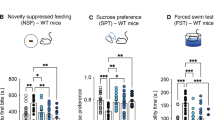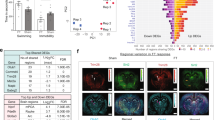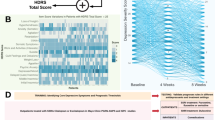Abstract
Serotonergic receptors of the 5-HT1A subtype have been suggested to play a pivotal role in the mechanism of action of antidepressant drugs, including specific serotonin reuptake inhibitors (SSRIs). We examined the effect of clinical doses of the SSRI, fluoxetine, on 5-HT1A receptor function in 15 normal volunteers. Hypothermic and hormone responses to the 5-HT1A receptor agonist, ipsapirone (0.3 mg per kg, per os) were examined after two weeks of placebo and again, after the subjects had been receiving fluoxetine for four weeks. On fluoxetine, the hypothermic response to ipsapirone was significantly blunted, as were ACTH, cortisol and growth hormone release. Ipsapirone plasma levels were significantly increased by fluoxetine but a pharmacokinetic effect could not have accounted for the observed blunting of 5-HT1A receptor mediated effects. These findings confirm and extend previous observations in rodents and humans and indicate that both post-synaptic 5-HT1A receptors in the hypothalamus, which mediate hormone responses to 5-HT1A agonists, and pre-synaptic 5-HT1A receptors which (putatively) mediate the hypothermic response, are rendered subsensitive by chronic SSRI administration. Since fluoxetine did not have significant effects on mood and other psychological variables in these subjects, alterations in 5-HT1A receptor function induced by SSRIs may have psychotropic relevance only in the context of existing perturbations of serotonergic function which underlie the psychopathological states in which these drugs are therapeutically effective.
Similar content being viewed by others
Log in or create a free account to read this content
Gain free access to this article, as well as selected content from this journal and more on nature.com
or
References
American Psychiatric Association. (1987): Committee on Nomenclature and Statistics. Diagnostic and Statistical Manual of Mental Disorders. 3rd ed. Washington, DC, American Psychiatric Association
Anderson IM, Deakin JFW, Miller HEJ . (1996): The effect of chronic fluvoxamine on hormonal and psychological responses to buspirone in normal volunteers. Psychopharmacology 128: 74–82
Auerbach SB, Hjorth S . (1995): Effect of chronic administration of the selective serotonin uptake inhibitor citalopram on extracellular 5-HT and apparent autoreceptor sensitivity in rat forebrain in vivo. N S Arch Pharmacol 352: 597–606
Bagdy G, Makara GB . (1994): Hypothalamic paraventricular nucleus lesions differentially affect serotonin1A (5-HT1A) and 5-HT2 receptor agonist-induced oxytocin, prolactin, and corticosterone responses. Endocrinology 134: 1127–1131
Berlin I, Warot D, Legout V, Guillement S, Schollnhammer G, Puech AJ . (1998): Blunted 5-HT1A receptor agonist-induced corticotropin and cortisol responses after long term ipsapirone and fluoxetine administration to healthy subjects. Clin Pharmacol Ther 63: 428–436
Bel N, Artigas F . (1993): Chronic treatment with fluvoxamine increases extracellular serotonin in frontal cortex but not in raphe nuclei. Synapse 15: 243–245
Bill DJ, Knight M, Forster EA, Fletcher A . (1991): Direct evidence for a species difference in the mechanism of 8-OH-DPAT-induced hypothermia. Br J Pharmacol 103: 1857–1864
Blier P, Bouchard C . (1992): Effect of repeated electroconvulsive shocks on serotonergic neurons. Eur J Pharmacol 211: 365–373
Blier P, de Montigny C . (1994): Current advances and trends in the treatment of depression. Trends Pharmacol Sci 15: 220–226
Blier P, Seletti B, Young SN, Benkelfat C, de Montigny C . (1994): Serotonin1A receptor activation and hypothermia: Evidence for a postsynaptic mechanism in humans. Neuropsychopharmacology 10 (suppl 35); 92S
Bosker FJ, Klompmakers AA, Westenberg HGM . (1995a): Effects of single and repeated oral administration of fluvoxamine on extracellular serotonin in the median raphe nucleus and dorsal hippocampus of the rat. Neuropharmacology 34: 501–508
Bosker FJ, van Essevelt KE, Klompmakers AA, Westenberg HGM . (1995b): Chronic treatment with fluvoxamine by osmotic minipumps fails to induce persistent functional changes in central 5-HT1A and 5-HT1B receptors, as measured by in vivo microdialysis in dorsal hippocampus of conscious rats. Psychopharmacology 117: 358–363
Chaouloff F . (1993): Physiopharmacological interactions between stress hormones and central serotonergic systems. Brain Res Rev 18: 1–32
Cowen PJ, Power AC, Ware CJ, Anderson IM . (1994): 5-HT1A receptor sensitivity in major depression: A neuroendocrine study with buspirone. Br J Psychiatry 164: 372–379
Cutler NR, Sramek JJ, Keppel-Hesselink JM, Krol A, Roeschen J, Rickels K, Schweizer E . (1993): A double-blind, placebo-controlled study comparing the efficacy and safety of ipsapirone versus lorazepam in patients with generalized anxiety disorder: A prospective multicenter trial. J Clin Psychopharmacol 6: 429–437
de Montigny C, Chaput Y, Blier P . (1990): Modification of serotonergic neuron properties by long-term treatment with serotonin reuptake blockers. J Clin Psychiatr 51 (suppl. B): 4–8
Gelfin Y, Gorfine M, Lerer B . (1998): Effect of clinically equivalent fluoxetine administration on mood and other psychological parameters in healthy volunteers. Am J Psychiatry 155: 290–292
Gelfin Y, Lerer B, Lesch KP, Gorfine M, Allolio B . (1995): Complex effects of age and gender on adrenocorticotrophic hormone and cortisol responses to ipsapirone challenge in normal subjects. Psychopharmacology 120: 356–364
Gilbert F, Brazell C, Tricklebank MD, Stahl SM . (1988): Activation of the 5-HT1A receptor subtype increases rat plasma ACTH concentrations. Eur J Pharmacol 147: 431–437
Goodwin GM, De Souza RJ, Green AR . (1985a): The pharmacology of the hypothermic response in mice to 8-hydroxy-2(di-n-propylamino)tetralin (8-OH-DPAT): A model of pre-synaptic 5-HT1 function. Neuropharmacology 24: 1187–1194
Goodwin GM, De Souza RJ, Green AR . (1985b): Pre-synaptic serotonin receptor-mediated response in mice attenuated by antidepressant drugs and electroconvulsive shock. Nature 317: 531–533
Goodwin GM, De Souza RJ, Green AR, Heal DJ . (1987a): The pharmacology of the behavioral and hypothermic responses of rats to 8-hydroxy-2(di-n-propylamino)tetralin (8-OH-DPAT). Psychopharmacology 91: 506–511
Goodwin GM, De Souza RJ, Green AR . (1987b): Attenuation by electroconvulsive shock and antidepressant drugs of the 5-HT1A receptor mediated hypothermia and serotonin syndrome produced by 8-OH-DPAT in the rat. Psychopharmacology 91: 500–505
Gur E, Lerer B, Newman ME . (1997): Chronic electroconvulsive shock and 5-HT autoreceptor activity in rat brain: an in vivo microdialysis study. J Neural Transm 104: 795–804
Gur E, Lerer B, Newman ME . (1999): Chronic clomipramine and triiodothyronine increase 5-HT levels in rat frontal cortex in vivo: Relationship to 5-HT autoreceptor activity. J Pharmacol Exp Ther 288: 81–87
Haleem DJ, Kennett GA, Whitton PS, Curzon G . (1989): 8-OH-DPAT increases corticosterone but not other 5-HT1A receptor-dependent responses more in females. Eur J Pharmacol 164: 435–443
Hensler JG, Kovachich GB, Frazer A . (1991): A quantitative autoradiographic study of serotonin1A receptor regulation: effect of 5,7-dihydroxytryptamine and antidepressant treatments. Neuropsychopharmacology 4: 131–144
Hillegaart V . (1991): Effects of local application of 5-HT and 8-OH-DPAT into the dorsal and median raphe nuclei on core temperature in the rat. Psychopharmacology 103: 291–296
Hjorth S . (1985): Hypothermia in the rat induced by the potent serotonergic agent 8-OH-DPAT. J Neural Transm 61: 131–135
Hjorth S, Auerbach SB . (1994): Lack of 5-HT1A autoreceptor desensitization following chronic citalopram treatment, as determined by in vivo microdialysis. Neuropharmacology 33: 331–334
Hutson PH, Donohoe TP, Curzon G . (1987): Hypothermia induced by putative 5-HT1A agonist LY 165163 and 8-OH-DPAT is not prevented by 5-HT depletion. Eur J Pharmacol 143: 121–128
Invernizzi R, Bramante M, Samanin R . (1994): Chronic treatment with citalopram facilitates the effect of a challenge dose on cortical serotonin output: Role of pre-synaptic 5-HT1A receptors. Eur J Pharmacol 260: 243–246
Invernizzi R, Bramante M, Samanin R . (1995): Extracellular concentrations of serotonin in the dorsal hippocampus after acute and chronic treatment with citalopram. Brain Res 696: 62–66
Invernizzi R, Bramante M, Samanin R . (1996): Role of 5-HT1A receptors in the effects of acute and chronic fluoxetine on extracellular serotonin in the frontal cortex. Pharmacol Biochem Behav 54: 143–147
Klimek V, Zak-Knapik J, Mackowiak M . (1994): Effects of repeated treatment with fluoxetine and citalopram, 5-HT uptake inhibitors, on 5-HT1A and 5-HT2 receptors in the rat brain. J Psychiatr Neurosci 19: 63–67
Knutson B, Wolkowitz OM, Cole SW, Chan T, Moore EA, Johnson RC, Terpstra J, Turner RA, Reus VI . (1998): Selective alteration of personality and social behavior by serotonergic intervention. Am J Psychiatry 155: 373–379
Koenig JI, Gudelsky GA, Meltzer HY . (1987): Stimulation of corticosterone and β-endorphin secretion in the rat by selective 5-HT receptor subtype activation. Eur J Pharmacol 137: 1–8
Kreiss DS, Lucki I . (1995): Effects of acute and repeated administration of antidepressant drugs on extracellular levels of 5-HT measured in vivo. J Pharmacol Exp Ther 274: 866–876
Lesch KP, Rupprecht R, Poten B, Muller U, Sohnle K, Fritze J, Schulte HM . (1989): Endocrine responses to 5-hydroxytryptamine1A receptor activation by ipsapirone in humans. Biol Psychiatry 26: 203–205
Lesch KP, Poten B, Soehnle K, Schulte HM . (1990a): Pharmacology of the hypothermic response to 5-HT1A receptor activation in humans. Eur J Clin Pharmacol 39: 17–19
Lesch KP, Soehnle K, Poten B, Rupprecht R, Schulte HM . (1990b): Corticotrophin and cortisol secretion following central 5-hydroxytryptamine1A (5-HT1A) receptor activation: Effects of 5-HT receptor and β-adrenoceptor antagonists. J Clin Endocrinol Metab 70: 670–674
Lesch KP, Mayer S, Disselkamp-Tietze J, Hoh A, Schoellnhammer G, Schulte HM . (1990c): Subsensitivity of the 5-Hydroxytryptamine1A (5-HT1A) receptor-mediated hypothermic response to ipsapirone in unipolar depression. Life Sciences 46: 1271–1277
Lesch KP, Mayer S, Disselkamp-Tietze J, Wiesmann M, Osterheider M, Schulte HM . (1990d): 5-HT1A receptor responsivity in unipolar depression: evaluation of ipsapirone-induced ACTH and cortisol secretion in patients and controls. Biol Psychiatry 28: 620–628
Lesch KP, Disselkamp-Tietze J, Schmidtke A . (1990e): 5-HT1A receptor function in unipolar depression: Effect of chronic amitriptyline treatment. J Neural Transm 180: 157–161
Lesch KP, Hoh A, Schulte HM, Osterheider M, Muller T . (1991): Long-term fluoxetine treatment decreases 5-HT1A receptor responsivity in obsessive-compulsive disorder. Psychopharmacology 105: 415–420
Li Q, Levy AD, Cabrera TM, Brownfield MS, Battaglia G, van der Kar L . (1993): Long-term fluoxetine, but not desipramine, inhibits the ACTH and oxytocin responses to the 5-HT1A agonist, 8-OH-DPAT, in male rats. Brain Res 630: 148–156
Li Q, Brownfield MS, Levy AD, Battaglia G, Cabrera TM, van de Kar L . (1994): Attenuation of hormone responses to the 5-HT1A agonist, ipsapirone, by long-term treatment with fluoxetine, but not desipramine, in male rats. Biol Psychiat 36: 300–308
Li Q, Muma NA, van der Kar L . (1996): Chronic fluoxetine induces a gradual desensitization of 5-HT1A receptors: reductions in hypothalamic and midbrain Gi and Go proteins and in neuroendocrine responses to a 5-HT1A agonist. J Pharmacol Exp Ther 279: 1035–1042
Li Q, Muma NA, Battaglia G, van der Kar L . (1997): A desensitization of hypothalamic 5-HT1A receptors by repeated injections of paroxetine: Reduction in the levels of Gi and Go proteins and neuroendocrine responses, but not in the density of 5-HT1A receptors. J Pharmacol Exp Ther 282: 1581–1590
Lichtenberg P, Shapira B, Blacker M, Gropp C, Calev A, Lerer B . (1992): Effect of fenfluramine on mood: A double-blind, placebo-controlled trial. Biol Psychiatry 31: 351–356
Maj J, Bijak M, Dziedzicka-Wasylewska M, Rogoz R, Rogoz Z, Skuza G, Tokarski T . (1996): The effects of paroxetine given repeatedly on the 5-HT receptor subpopulations in the rat brain. Psychopharmacology 127: 73–82
Maj J, Moryl E . (1992): Effect of sertraline and citalopram given repeatedly on the responsiveness of 5-HT receptor subpopulations. J Neural Transm 88: 143–156
Meltzer HY, Bastani B, Jayathilake K, Maes M . (1997): Fluoxetine, but not tricyclic antidepressants, potentiates the 5-hydroxytryptophan-mediated increase in plasma cortisol and prolactin secretion in subjects with major depression or with obsessive compulsive disorder. Neuropsychopharmacology 17: 1–11
Meltzer HY, Maes M . (1994): Effect of pindolol on the L-5-HTP-induced increase in plasma prolactin and cortisol concentrations in man. Psychopharmacology 114: 635–643
Meltzer HY, Maes M . (1995): Effects of ipsapirone on plasma cortisol and body temperature in major depression. Biol Psychiatry 38: 450–457
Meltzer HY, Wiita B, Robertson A, Tricou BJ, Lowy M, Perline R . (1984): Effect of 5-hydroxytryptophan on serum cortisol levels in major affective disorders: Enhanced response in depression and mania. Arch Gen Psychiatr 41: 366–374
Millan MJ, Rivet J-M, Canton H, LeMarouille-Girardon S, Gobert A . (1993): Induction of hypothermia as a model of 5-hydroxytryptamine1A receptor-mediated activity in the rat: A pharmacological characterization of the actions of novel agonists and antagonists. J Pharmacol Exp Ther 264: 1364–1376
Mongeau R, Blier P, de Montigny C . (1997): The serotonergic and noradrenergic systems of the hippocampus: Their interactions and the effects of antidepressant treatments. Brain Res Review 23: 145–195
Newman ME, Drummer D, Lerer B . (1990): Single and combined effects of desipramine and lithium on serotonergic receptor number and second messenger function in rat brain. J Pharmacol Exp Ther 252: 826–831
Newman ME, Lerer B . (1988): Chronic electroconvulsive shock and desipramine reduce the degree of inhibition of 5 HT and carbachol of forskolin stimulated adenylate cyclase in rat hippocampal membranes. Europ J Pharmacol 148: 257–260
Newman ME, Shapira B, Lerer B . (1992): Regulation of 5-HT1A receptor function in rat hippocampus by short- and long-term administration of 5-HT1A agonists and antidepressants. J Pharmacol Exp Ther 260: 16–20
O'Connell MT, Sarna G, Curzon G . (1992): Evidence for postsynaptic mediation of the hypothermic effect of 5-HT1A receptor activation. Br J Pharmacol 106: 603–609
O'Donnell JM, Grealy M . (1992): Neuroendocrine response to clonidine and 8-OH-DPAT in rats following chronic administration of desipramine or sertraline. Br J Pharmacol 105: 863–868
Peroutka SJ . (1988): 5-Hydroxytryptamine receptor subtypes: molecular, biochemical and physiological characterization. Trends Neurosci 11: 496–500
Przegalinski E, Warchol-Kania A, Budziszewska B . (1989): The lack of effect of repeated treatment with antidepressant drugs on the 8-OH-DPAT-induced increase in the serum corticosterone concentration. Pol J Pharmacol Pharm 41: 63–68
Rutter JJ, Gundlah C, Auerbach SB . (1994): Increase in extracellular serotonin produced by uptake inhibitors is enhanced after chronic treatment with fluoxetine. Neurosci Lett 171: 183–186
Sargent P, Williamson DJ, Pearson G, Odontiadis J, Cowen PH . (1997): Effect of paroxetine and nefazodone on 5-HT1A receptor sensitivity. Psychopharmacology 132: 296–302
Spitzer RL, Endicott J . (1978): Schedule for Affective Disorders and Schizophrenia—Lifetime Version (SADS-L). New York, New York State Psychiatric Institute
Tanda G, Frau R, di Chiara G . (1996): Chronic desipramine and fluoxetine differentially affect extracellular dopamine in the rat prefrontal cortex. Psychopharmacology 127: 83–87
Traber J, Glaser T . (1987): 5-HT1A receptor-related anxiolytics. Trends Pharmacol Sci 8: 432–437
Welner SA, de Montigny C, desRoches J, desJardins P, Suranyi-Cadotte BE . (1989): Autoradiographic quanitification of serotonin1A receptors in rat brain following antidepressant drug treatment. Synapse 4: 347–352
Acknowledgements
The authors thank Dr. Michael Franklin, University Department of Psychiatry, Warneford Hospital, Oxford for measurement of plasma growth hormone, ipsapirone, and fluoxetine levels. Ipsapirone tablets were supplied by Tropon, Bayer.
Author information
Authors and Affiliations
Rights and permissions
About this article
Cite this article
Lerer, B., Gelfin, Y., Gorfine, M. et al. 5-HT1A Receptor Function in Normal Subjects on Clinical Doses of Fluoxetine: Blunted Temperature and Hormone Responses to Ipsapirone Challenge. Neuropsychopharmacol 20, 628–639 (1999). https://doi.org/10.1016/S0893-133X(98)00106-7
Received:
Accepted:
Issue date:
DOI: https://doi.org/10.1016/S0893-133X(98)00106-7
Keywords
This article is cited by
-
Slow-release delivery enhances the pharmacological properties of oral 5-hydroxytryptophan: mouse proof-of-concept
Neuropsychopharmacology (2019)
-
Deficient serotonin neurotransmission and depression-like serotonin biomarker alterations in tryptophan hydroxylase 2 (Tph2) loss-of-function mice
Molecular Psychiatry (2012)
-
Pharmacology of ayahuasca administered in two repeated doses
Psychopharmacology (2012)
-
5HT1A-mediated stimulation of cortisol release in major depression: use of non-invasive cortisol measurements to predict clinical response
European Archives of Psychiatry and Clinical Neuroscience (2010)
-
Influence of escitalopram treatment on 5-HT1A receptor binding in limbic regions in patients with anxiety disorders
Molecular Psychiatry (2009)



